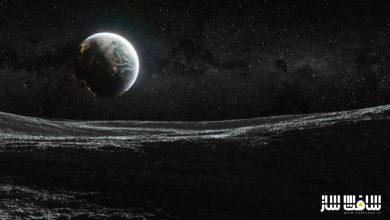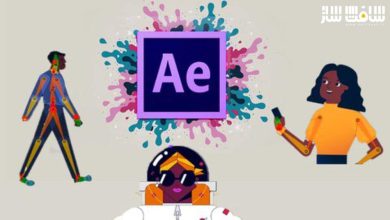آموزش بنیادین موشن گرافیک در Cinema 4D
CGMA – Motion Graphics

آموزش بنیادین موشن گرافیک در Cinema 4D
این آموزش بنیادین موشن گرافیک در Cinema 4D برای کسانی در نظر گرفته شده که درصدد جهشی تازه در دنیای موشن گرافیک هستند یعنی کسانی که میخواهند به مهارت های خود در دنیای موشن بال و پر بدهند.
بر کسی پوشیده نیست که نام حرفه ” موشن گرافیک ” با نرم افزار سینما فوردی عجین شده است به همین خاطر مدرس این دوره تا جایی ک توانسته اصول و رازههای نرم افزار سینما فوردی را برای علاقه مندان به این حوزه برملا ساخته تا شما را با دنیای وسیع تری از این حرفه روبرو کند.
شعار مدرس این دوره این است ” هر چه بیشتر بدانید ، بهتر است ” به همین خاطر این اطمینان را به شما می دهم که پس از تماشای محتویات این دوره و به کارگیری تمرین های درسی آن شما قادر به ساخت صحنه هایی هستید که در زمره کارهای حرفه ای ارزیابی شود .
هفته اول : در هفته اول نگاهی اجمالی به نرم افزار Cinema 4D و After Effects میکنیم سپس تمامی قسمت های آن را به صورت مروری مورد بررسی قرار می دهیم تا از حداقل های این دو نرم افزار مذکور مطلع باشید.
هفته دوم : اکنون ک فضای کاری خود را برای کارهای حرفه ای مهیا کردید وقت آن است به کارهای حرفه ای تر بپردازیم در این هفته به اصولی ترین مباحثی میپردازیم ک هر موشن گرافیستی موظف به رعایت آن است از جمله نکات مهمی که در این هفته به شرح آن خواهیم پرداخت شامل Subdivision Surface ، استفاده از Deformers و سایر نکاتی ک باید از آنها در کارهای خود استفاده کنید.
هفته سوم: در این هفته اقدام به مدلسازی است و المان هایی میکنیم ک متعاقبا باید در کار رندر و انیمیشن و کامپوزیت مورد استفاده قرار دهیم.
هفته چهارم : در این هفته به متجرک سازی المان های میپردازیم ک در هفته های گذشته اقدام به مدلسازی و ساخت آن کردیم پیشنهاد میکنم درس های این هفته را از دست ندهید چون واقعا میتواند نظر شما را جلب کند.
هفته پنجم : در این جلسه به بررسی تایم لاین و ابزارهایی میپردازیم که بهتر بتوانید المان های خود را متحرک سازی کنید.
هفته ششم : رندرینگ از جمله قسمت های شیرین نرم افزار های سه بعدی است در این آموزش از موتور رندر Octane برای رندر نهایی استفاده میکنیم و سپس به بررسی پارامتر های موجود در این موتور رندر می پردازیم.
هفته هفتم و هشتم : در این دو هفته مفصل به شرح مباحث کامپوزیت و پست پروداکشن میپردازیم و به شما یاد می دهیم چگونه بهترین خروجی را از رندر خود بگیرید. این دوره آموزشی توسط تیم ســافــت ســاز برای شما عزیزان تهیه شده است.
عنوان دوره : CGMA – Motion Graphics
سطح : متوسط
زمان کل دوره : – ساعت
تعداد فایل های تصویری : 74
سال آموزش : 2020
فایل تمرینی : –
مربی دوره : FERDINANDO SPAGNOLO
نرم افزار : Cinema 4D, After Effects
زیرنویس انگلیسی : ندارد
CGMA – Motion Graphics
Motion Graphics is the perfect course for those taking a fresh leap into the world of motion graphics, those wanting to sharpen their existing skills, and everyone in between. Covering the fundamental principles that go into making exceptional motion graphics—concept, design, animation, 3D design, rendering and compositing—this course has been created with professional output in mind. The key to creating outstanding work is nailing these three key areas: concept, design, and execution. This course will cover the core processes involved in conceptualizing and executing a motion graphics sequence, using tried and tested industry-standard methods.
Week 1 | Introduction to Motion Graphics
In this first week, we’ll explore and optimise our C4D and After Effects workspaces. Go through the ideation process and outline some basic theory around design, 3D design and animation | Introduction to software used in course | Introduction to basic motion graphic principles | Design | Establishing a concept/direction | Consolidating your idea
Week 2 | 3D Design and Art Direction Part 1 – Modeling Hero Content
Now that we’ve got our workspaces set up and a grasp on some basic fundamental principles, it’s time to get designing. In any motion graphics project, one of the first things you’ll want to do is create a set of strong visual targets: styleframes. | Introduction to subdivision surface modelling | Using C4D deformers to aid the modelling process | Points, edges, polygons, topology | Camera selection for the right shot feel
Week 3 | 3D Design and Art Direction Part 2
Once we’ve modeled our main assets and setup up a rough composition for the scene, we’ll continue to set up shaders, lighting and render settings. For your render to really pop, you need all four (geometry, shading, lighting, rendering)of these components to work in harmony. | Introduction to texturing principles in C4D/Octane (theory applicable to any render engine) | Texture mapping and setting up shaders | Introduction to lighting and mood | Setting up render passes
Week 4 | 2D Design and Art Direction
Now that we’ve modeled, textured, lit, and rendered our scenes, it’s time to take those render passes into After Effects and give them some compositing love. We’ll also build up a library of vector assets in Adobe Illustrator and use them to populate our scenes with some 2D graphics. Throughout this process we will solidify our concept/narrative by finessing our designs and lay a solid foundation for when we transition into the production phase and begin animating our scenes.
Week 5 | 3D Animation
With our visual targets set, it’s time to jump back into C4D and animate our scenes. In this session we’ll go deep into C4D’s animation timeline and cover techniques from tweaking your f-curves to baking animation to render over a network. We’ll also explore how to use C4D’s deformers and mograph modules to bring your models to life. | Creating animatics for timing | Rigging your setups for animation | Animation using falloff | Animation using vertex maps | Camera animation | Tweaking those curves for dynamic animation
Week 6 | Rendering
Rendering is a hot topic right now filled with much debate. GPU vs CPU rendering? Which machine should I buy (Mac vs PC)? This week Nik will share his thoughts and experiences on GPU vs CPU rendering as well as the hardware he’s built to optimize his workflow. We’ll also go through rendering our scenes using a popular GPU renderer –Octane—and will also take a brief look into rendering the same scenes with C4D’s standard render and Arnold render, exploring the benefits each render engine has to offer.
Week 7 | 2D Animation
This week, we’ll take our vector graphics that we designed in week 4, pull them into After Effects, and start animating them. This session will include rebuilding assets as shape layers for optimal file size and efficiency and creating transitional elements to populate our sequences. We’ll go deeper into the After Effects timeline and explore keyframe interpolation and f-curves.
Week 8 | Compositing Sequence
In this final week we’ll bring it all together. We’ll take our renders from C4D and our animated vector graphics and pull everything into a fully formed motion graphics sequence inside of After Effects. Adding little flourishes throughout, from speed ramps to trimming frames off our edit and adding a final grade. This is the final chance to take your sequences to the next level and get it ready for sound design.
حجم کل : 10.4 گیگابایت

برای دسترسی به کل محتویات سایت عضو ویژه سایت شوید
برای نمایش این مطلب و دسترسی به هزاران مطالب آموزشی نسبت به تهیه اکانت ویژه از لینک زیر اقدام کنید .
دریافت اشتراک ویژه
مزیت های عضویت ویژه :
- دسترسی به همه مطالب سافت ساز
- آپدیت روزانه مطالب سایت از بهترین سایت های سی جی
- ورود نامحدود کاربران از هر دیوایسی
- دسترسی به آموزش نصب کامل پلاگین ها و نرم افزار ها
اگر در تهیه اشتراک ویژه مشکل دارید میتونید از این لینک راهنمایی تهیه اشتراک ویژه رو مطالعه کنید . لینک راهنما
For International user, You can also stay connected with online support. email : info@softsaaz.ir telegram : @SoftSaaz
امتیاز به این مطلب :
امتیاز سافت ساز
لطفا به این مطلب امتیاز دهید :)






